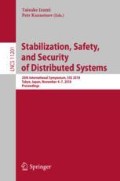Abstract
“Stable marriage” refers to a particular matching with constraints having a wide variety of applications in different domains (two-sided markets, Cloud computing, college admissions, etc.). Most of the studies on this problem performed up to now were for centralized and synchronous settings assuming initialization. We consider a distributed and asynchronous context, without initialization (i.e., in a self-stabilizing manner, tolerating any transient fault) and with some confidentiality requirements. The single already known self-stabilizing solution in Laveau et al. (SSS’ 2017), based on Ackerman et al.’s algorithm (SICOMP’ 2011), stabilizes in \(O(n^4)\) moves (activation of a single node). We improve on this previous result considerably by presenting a solution with \(O(n^2)\) steps, relying on the idea of Gale and Shapley’s algorithm (AMM 1962), which takes also \(O(n^2)\) moves, but in a centralized synchronous context. Moreover it is not self-sabilizing solution and a corruption cannot be repaired locally, as noticed by Knuth (1976).
The full version of the paper is available in [6].
This work was supported in part by grants from Digiteo France and by the Israeli ministry of Science and Technology.
Access this chapter
Tax calculation will be finalised at checkout
Purchases are for personal use only
References
Ackermann, H., Goldberg, P.W., Mirrokni, V.S., Röglin, H., Vöcking, B.: Uncoordinated two-sided matching markets. SIAM J. Comput. 40, 92–106 (2011)
Afek, Y., Kutten, S., Yung, M.: Memory-efficient self stabilizing protocols for general networks. In: van Leeuwen, J., Santoro, N. (eds.) WDAG 1990. LNCS, vol. 486, pp. 15–28. Springer, Heidelberg (1991). https://doi.org/10.1007/3-540-54099-7_2
Arora, A., Gouda, M.: Distributed reset. IEEE Trans. Comp. 43, 1026–1038 (1994)
Awerbuch, B., Patt-Shamir, B., Varghese, G.: Self-stabilization by local checking and correction. In: Proceedings of 32nd Annual Symposium of Foundations of Computer Science (1991)
Awerbuch, B., Patt-Shamir, B., Varghese, G., Dolev, S.: Self-stabilization by local checking and global reset. In: Tel, G., Vitányi, P. (eds.) WDAG 1994. LNCS, vol. 857, pp. 326–339. Springer, Heidelberg (1994). https://doi.org/10.1007/BFb0020443
Beauquier, J., Bernard, T., Burman, J., Kutten, S., Laveau, M.: Time efficient self-stabilizing stable marriage. Technical report (2018). https://hal.inria.fr/hal-01266028
Dijkstra, E.W.: Self-stabilizing systems in spite of distributed control. CACM 17, 643–644 (1974)
Dolev, S., Israeli, A., Moran, S.: Self-stabilization of dynamic systems assuming only read/write atomicity. Distrib. Comput. 7(1), 3–16 (1993)
Gale, D., Shapley, L.S.: College admissions and the stability of marriage. The American Mathematical Monthly (1962)
Gonczarowski, Y.A., Nisan, N., Ostrovsky, R., Rosenbaum, W.: A stable marriage requires communication. In: SODA 2015 (2015)
Knuth, D.E.: Mariages stables et leurs relations avec d’autres problemes combinatoires. Les Presses de l’Université de Montréal (1976)
Laveau, M., Manoussakis, G., Beauquier, J., Bernard, T., Burman, J., Cohen, J., Pilard, L.: Self-stabilizing distributed stable marriage. In: Spirakis, P., Tsigas, P. (eds.) SSS 2017. LNCS, vol. 10616, pp. 46–61. Springer, Cham (2017). https://doi.org/10.1007/978-3-319-69084-1_4
Yao, A.C.-C.: Some complexity questions related to distributive computing (preliminary report). In: STOC 1979. ACM (1979)
Author information
Authors and Affiliations
Corresponding author
Editor information
Editors and Affiliations
Rights and permissions
Copyright information
© 2018 Springer Nature Switzerland AG
About this paper
Cite this paper
Beauquier, J., Bernard, T., Burman, J., Kutten, S., Laveau, M. (2018). Brief Announcement: Time Efficient Self-stabilizing Stable Marriage. In: Izumi, T., Kuznetsov, P. (eds) Stabilization, Safety, and Security of Distributed Systems. SSS 2018. Lecture Notes in Computer Science(), vol 11201. Springer, Cham. https://doi.org/10.1007/978-3-030-03232-6_26
Download citation
DOI: https://doi.org/10.1007/978-3-030-03232-6_26
Published:
Publisher Name: Springer, Cham
Print ISBN: 978-3-030-03231-9
Online ISBN: 978-3-030-03232-6
eBook Packages: Computer ScienceComputer Science (R0)

